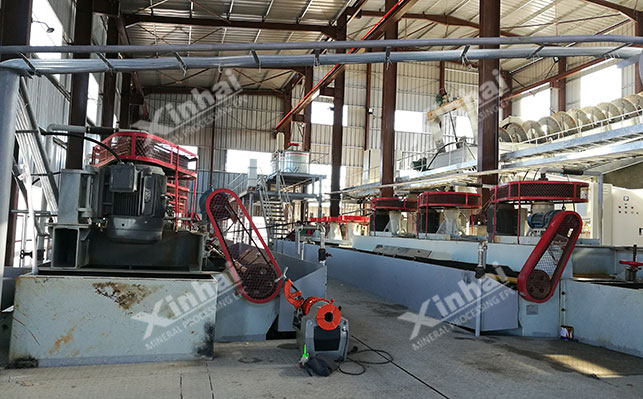The flotation process is commonly used to extract lithium from spodumene. For spodumene with different properties, the flotation process applied is slightly different, and the selection of flotation reagents is also very particular. The flotation lithium extraction process mainly includes the following four types:

This method is a common beneficiation process for spodumene. Because in the flotation process, the performance of collector, the proportion of regulator and the content of slime will affect the beneficiation indexes of spodumene. Therefore, before the flotation process, the concentrator will set the desliming process in advance to avoid the impact of slime, and Na2CO3 or NaOH can be added to the pulp to adjust the pH value. After desliming in advance, HP collector and CaCl2 regulator are added into the pulp, and the Li2O and spodumene concentrates can be recovered by adopting a closed flotation process of one coarse, two fine and two sweeps. The flotation method can also be used for the pre desliming of spodumene to obtain higher flotation indexes.
This method is to add alkaline solution before the pulp flotation, and carry out strong agitation to achieve the purpose of slime dispersion and improve the flotation environment. Finally, spodumene can be directly flotation out by adding collector to the pulp. The concentrate recovery rate of this method is high. At the same time, the grade of spodumene concentrate can be improved by selecting appropriate collectors (oxidized paraffin soap, naphthenic acid soap, sodium oleate and salicylhydroxamic acid), reasonable grinding fineness and cleaning operation times.
When spodumene is enriched by reverse flotation, Na2CO3 or NaOH is usually added to the pulp to adjust the pH to weak alkalinity. After that, an appropriate amount of dextrin (or starch) is added into the pulp to selectively inhibit spodumene, and then amine collectors are used to remove gangue minerals such as quartz and feldspar from the pulp. The tailings after impurity removal are spodumene concentrate. Spodumene reverse flotation is commonly used in roughing stage and concentrate purification stage.
This method is that after the slurry is added with the collector, the fine minerals will agglomerate with each other in the high-speed moving fluid by virtue of the association of the collector molecules, and finally form a hydrophobic cluster. These fine mineral aggregates float up and separate from gangue minerals to achieve the purpose of recovering concentrate. This method can be applied to the recovery of spodumene micro fine minerals.
The commonly used reagents for extracting lithium from spodumene are "three bases and two soaps" (three bases: sodium sulfide, sodium carbonate and sodium hydroxide, and two soaps: oxidized paraffin soap and naphthenic acid soap). The details are as follows:
Regulators used for spodumene can be divided into two categories: one is used to activate spodumene, which mainly includes metal cations, sodium hydroxide, sodium carbonate, etc. The other is used to inhibit spodumene, mainly including sodium sulfide, sodium hexametaphosphate, dextrin, starch, etc.
The collectors are mainly composed of anionic collectors and cationic collectors. Among them, anionic collectors include sodium oleate, oxidized paraffin soap, naphthenic acid soap, sodium dodecyl sulfonate, hydroxamic acid, etc. These collectors have the characteristics of good selectivity and weak collection capacity, and are used in the positive flotation process of spodumene; Cationic collectors mainly include dodecylamine, coconut amine, etc. These cationic collectors have poor selectivity but strong collecting ability and good foaming property, so they are mostly used for reverse flotation of spodumene.
The above is the introduction of the commonly used flotation process and flotation reagents for extracting lithium from spodumene. The formulation of any beneficiation process should follow the results of beneficiation test, because there are no two identical mines in the world, and the ore properties have their own characteristics.